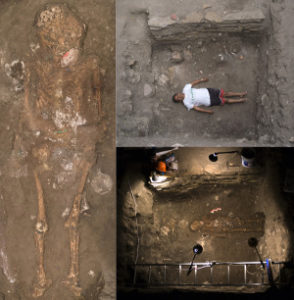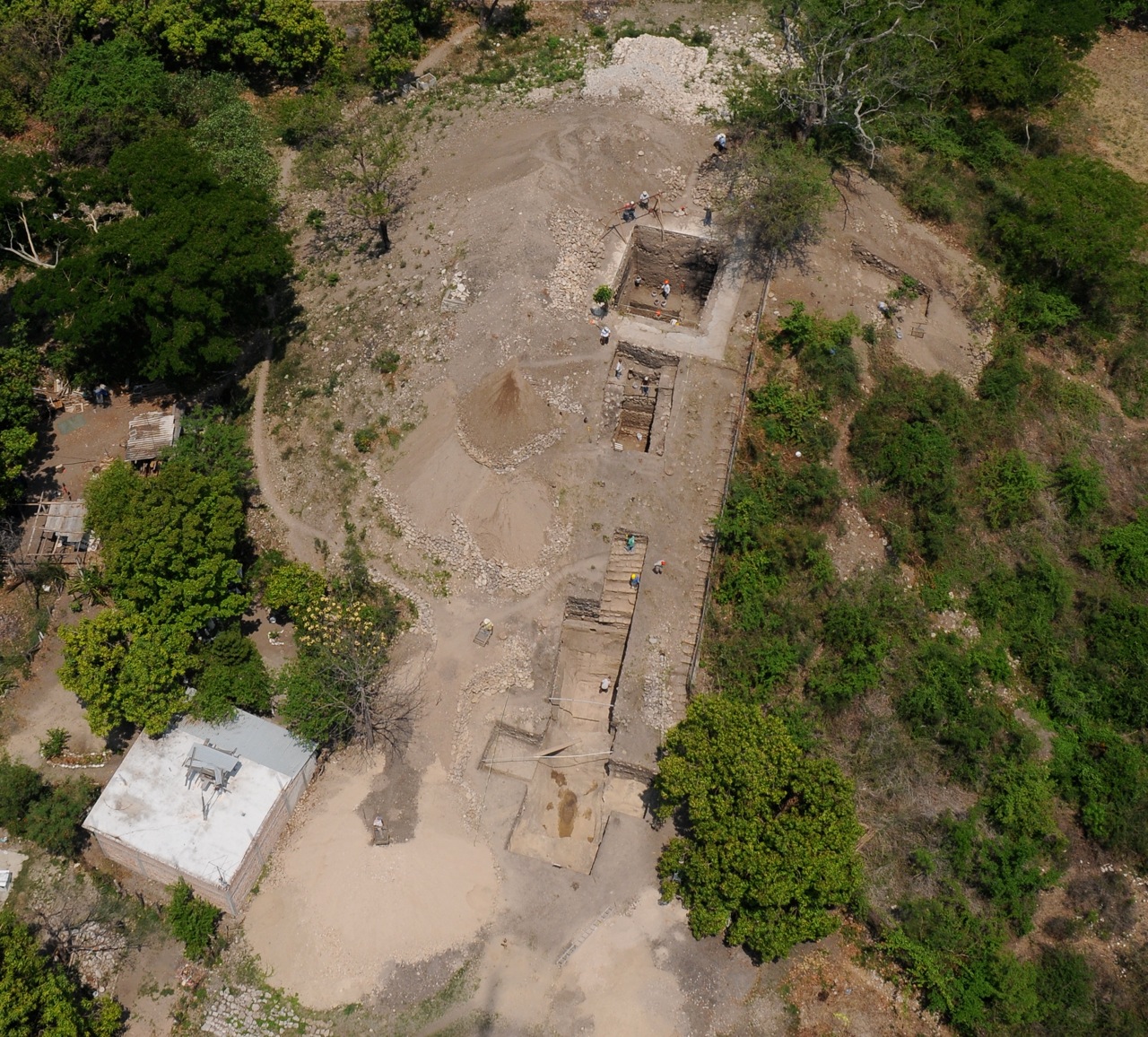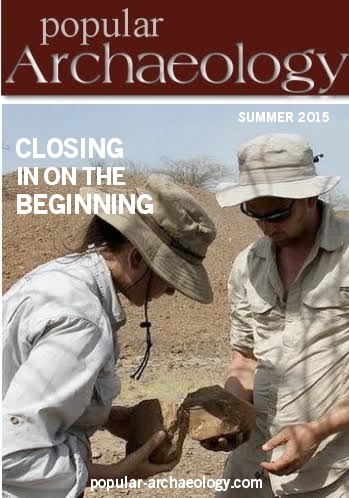
A 2,700-year-old pyramid tomb excavated in the western Chiapas state of Mexico, and the monumental center in which it was discovered, opened a window on the possible origins or connections it may have to a well-known ancient Olmec capital to its east on the Mexican Gulf Coast. The discovery has presented a tantalizing new piece in the emerging picture of state formation in southern Mexico and of a people and civilization that may have had trade and cultural affiliations with La Venta and possibly other Olmec centers from 1,000 to 400 B.C.
Known as Chiapa de Corzo, the site was excavated in 2010 by archaeologist Bruce Bachand of Brigham Young University’s New World Archaeological Foundation, along with Emiliano Gallaga of Mexico’s National Institute of Anthropology and History and Lynneth Lowe of the National Autonomous University of Mexico. The tomb contained two regally adorned individuals, one an adult male and the other an adult female. Given the nature of the burial and finds, they had clearly uncovered a royal tomb, a tomb that, when it was discovered, predated by 600 years any other such tomb found in Mesoamerica, including that of the familiar ancient Maya sites at Tikal and Kaminaljuyu.
“The main occupants were likely a conjugal pair that governed Chiapa de Corzo and the surounding countryside,” said Bachand. “The tomb exhibits Olmec rather than Maya affinities. Jade beads fashioned into duck heads, clamshells, pumpkin-shaped gourds, and bamboo shoots are similar to artifacts excavated seventy years ago at the mammoth Gulf Olmec site of La Venta. Green and gray obsidian disks—eye pieces for wooden or textile masks now long decayed—are also similar to pairs of disks found in a tomb and offering at La Venta”.
Similarities notwithstanding, the site also exhibited characteristics unique to its particular culture. Said Bachand, “when objects like these are discovered it is easy to overlook or downplay what is unique or distinct about the context. The absence of large jade earspools on the heads of the deceased (a signature Olmec trait), and the placement of clamshells over their mouths (a practice that continued for centuries in Chiapas), appear to be expressions of local identity and belief.”
_______________________________________________________________________________________________________________________
 Mound 11 (the tomb) at the height of excavation in April of 2010 (photograph by Oscar López, courtesy of INAH, Mexico).
Mound 11 (the tomb) at the height of excavation in April of 2010 (photograph by Oscar López, courtesy of INAH, Mexico).
________________________________________________________________________________________________________________________
Equally significant was the discovery of several offering pits near the pyramid tomb, containing artifacts identified as ritual stone axes, greenstone axes, a serpentine axe with an engraved image of an Olmec deity, and an elaborate sacrificial burial. The artifacts and burial, the alignment of the pits with the pyramidal tomb, and the nature and arrangement of subsequent deposits and monumental structures throughout the site of Chiapa de Corzo suggest that it was a center of continuous ritual activity. Moreover, the size, shape and arrangement of certain central mounds at the site, which includes the tomb mound, resemble the familiar “E-Group” formations found at other Chiapas region sites dated to 900 – 800 B.C., 200 years before it appeared in the later Maya sites. Analysis of findings at the pyramidal tomb mound indicate an association between the “E-Group” configuration and human sacrifice, rulership, the cardinal directions, lighting, corn, and community ritual, all related to Olmec views of the supernatural.
The excavations at Chiapa de Corzo have raised perhaps more questions than answers, but ongoing investigations and research continue to open the door on who these people were and what connections they had with other civilizations and centers of Mesoamerica.
To be sure, some elements of the larger picture have already come into focus. Reported Bachand: “The last twenty years of archaeological and linguistic research have demonstrated that Chiapa de Corzo and west-central Chiapas were home to the Zoque, descendants of the Mixe-zoque speaking Olmec who inhabited the Gulf and Pacific coasts of southern Mexico during the Early Formative Period (1500 – 1000 B.C.). Recognizing ancient Chiapa de Corzans as Zoque has ramifications for understanding the ethnic composition of Middle Formative (1000 – 400 B.C.) Gulf Olmec centers such as La Venta……..the two centers shared a common Early Formative Mixe-zoque heritage.”
Were the two centers closely related and representative of the same population and culture? According to Bachand, the jury is still out on this question.
“It would be rash to envision La Venta or Chiapa de Corzo as immiscible entities; La Venta was surely the more cosmopolitan of the two. But if one culture can be pegged for playing a dominant role in La Venta’s florescence, it would have to be the Zoque, considering the many ties seen in architecture, site planning, and sumptuary items across the two regions.”
_____________________________________________________
Cover Photo, Top: The skeleton of Tomb 1’s main occupant: a regally adorned middle aged male. His skull was crushed like a pancake when the tomb collapsed anciently. White residues on his lower torso and pelvis are probable vestiges of bark cloth attire. Remnants of a shell-decorated loin cloth descend from the pubic area. (photographs by Bruce R. Bachand, courtesy of INAH, Mexico).
 Read more in-depth articles about archaeology with a premium subscription to Popular Archaeology Magazine.
Read more in-depth articles about archaeology with a premium subscription to Popular Archaeology Magazine.
In addition, the latest Popular Archaeology ebook is now available.
______________________________________________
Travel and learn with Far Horizons.
____________________________________________
 Popular Archaeology’s annual Discovery Edition eBook is a selection of the best stories published in Popular Archaeology Magazine in past issues, with an emphasis on some of the most significant, groundbreaking, or fascinating discoveries in the fields of archaeology and paleoanthropology and related fields. At least some of the articles have been updated or revised specifically for the Discovery edition. We can confidently say that there is no other single issue of an archaeology-related magazine, paper print or online, that contains as much major feature article content as this one. The latest issue, volume 2, has just been released. Go to the Discovery edition page for more information.
Popular Archaeology’s annual Discovery Edition eBook is a selection of the best stories published in Popular Archaeology Magazine in past issues, with an emphasis on some of the most significant, groundbreaking, or fascinating discoveries in the fields of archaeology and paleoanthropology and related fields. At least some of the articles have been updated or revised specifically for the Discovery edition. We can confidently say that there is no other single issue of an archaeology-related magazine, paper print or online, that contains as much major feature article content as this one. The latest issue, volume 2, has just been released. Go to the Discovery edition page for more information.
____________________________________________







